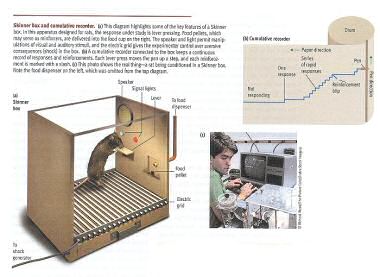The Skinner Box
A Skinner box typically contains one or more levers which an animal can press, one or more stimulus lights and one or more places in which reinforcers like food can be delivered. The animal's presses on the levers can be detected and recorded and a contingency between these presses, the state of the stimulus lights and the delivery of reinforcement can be set up, all automatically. It is also possible to deliver other reinforcers such as water or to deliver punishers like electric shock through the floor of the chamber. Other types of response can be measured - nose-poking at a moving panel, or hopping on a treadle - both often used when testing birds rather than rats. And of course all kinds of discriminative stimuli may be used.

click on image to enlarge
Training a Rat in the Skinner Box
In principle, and sometimes in practice, it is possible for a rat to learn to press a bar in a Skinner-box by trial and error. If the box is programmed so that a single lever-press causes a pellet to be dispensed, followed by a period for the rat to eat the pellet when the discriminative-stimulus light is out and the lever inoperative, then the rat may learn to press the lever if left to his own devices for long enough. This can, however, often take a very long time. The methods used in practice illustrate how much the rat has to learn to tackle this simple instrumental learning situation. The first step is to expose the rat to the food pellets he will later be rewarded with in the Skinner box in his home cage when he is hungry. He has to learn that these pellets are food and hence are reinforcing when he is hungry. Now he can be introduced to the Skinner-box.
Initially there may be a few pellets in the hopper where reinforcers are delivered, plus a few scattered nearby, to allow the rat to discover that the hopper is a likely source of food. Once the rat is happy eating from the hopper he can be left in Skinner box and the pellet dispenser operated every now and then so the rat becomes accustomed to eating a pellet from the hopper each time the dispenser operates (the rat is probably learning to associate the sound of the dispenser operating with food - a piece of classical conditioning which is really incidental to the instrumental learning task at hand). Once the animal has learned the food pellets are reinforcing and where they are to be found, it would, however, still probably take some time for the rat to learn that bar-pressing when the SD light was on produced food. The problem is that the rat is extremely unlikely to press the lever often by chance. In order to learn an operant contingency by trial and error the operant must be some behavior which the animal performs often anyway. Instead of allowing the rat to learn by trial and error one can use a 'shaping' or 'successive-approximations' procedure. Initially, instead of rewarding the rat for producing the exact behavior we require - lever pressing - he is rewarded whenever he performs a behavior which approximates to lever pressing. The closeness of the approximation to the desired behavior required in order for the rat to get a pellet is gradually increased so that eventually he is only reinforced for pressing the lever. Starting by reinforcing the animal whenever he is in the front half of the Skinner-box, he is later only reinforced if he is also on the side of the box where the lever is. After this the reinforcement occurs if his head is pointing towards the lever and then later only when he approaches the lever, when he touches the lever with the front half of his body, when he puts touches the lever with his paw and so on until the rat is pressing the lever in order to obtain the reinforcer. The rat may still not have completely learned the operant contingency - specifically he may not yet have learned that the contingency between the operant response and reinforcement is signalled by the SD light. If we now leave him to work in the Skinner-box on his own he will soon learn this and will only press the lever when the SD light is on.
This article is restructured from a lecture kindly provided by R.W.Kentridge.
Watch a video of a rat pressing a lever in a Skinner-box:
Martin Heisenberg and Reinhard Wolf have developed a general model of operant behavior, which joins a description of some more features of operant conditioning.